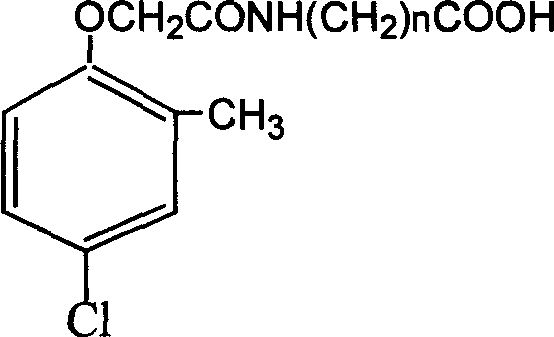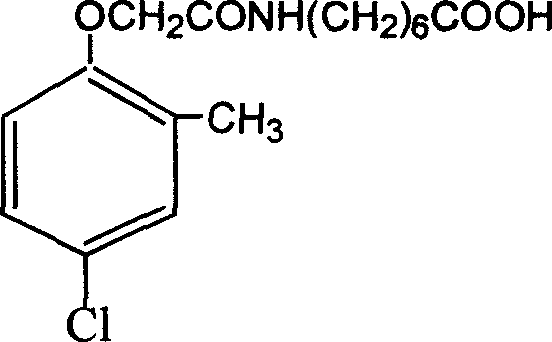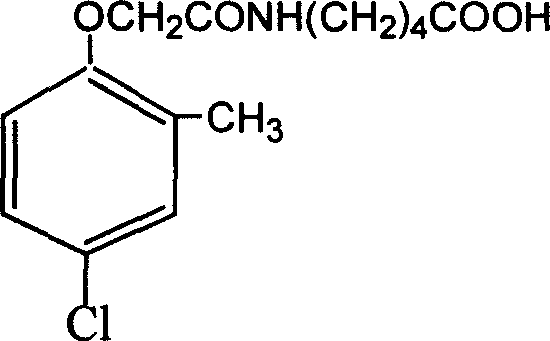Method for preparing 2 metho 4 chlorine artificial half antigen, artificial antigen, specific antibody and application
An artificial hapten and antibody technology, applied in chemical instruments and methods, specific peptides, carrier-bound/immobilized peptides, etc., can solve the problems of cumbersome process, great influence, unsuitable for large-scale sample detection and analysis, etc., and achieve high sensitivity High, specificity, and easy on-site monitoring effect
- Summary
- Abstract
- Description
- Claims
- Application Information
AI Technical Summary
Problems solved by technology
Method used
Image
Examples
preparation example Construction
[0040] 3 Preparation of antibody and establishment of ELISA method for 2-methyl-4-chloride
[0041]Three immunogen complexes prepared by coupling hapten M, MC and MB to protein were immunized with three rabbits according to conventional methods. From the second time of booster immunization, blood was collected from the rabbit's ear vein on the 8th day after each immunization, and the titer of the serum was determined by indirect ELISA after appropriate dilution. After the fourth immunization, the rabbits obtained high-titer antibodies, and the titers of antiserum were 1:25600, 1:12800, 1:12800; 1:25600, 1:12800, 1:51200; 1:51200, 1:51200 and 1:102400. After the immune serum is qualified, blood is collected to separate the antiserum.
[0042] The ELISA method of 2A4Cl was established by using the 2A4C antigen antibody immunoreaction and enzymatic reaction. It has high specificity and sensitivity in the detection and analysis of 2-methyl-4-chlorine residues in food, plants, e...
Embodiment 1
[0043] Example 1: Synthesis of Hapten MC
[0044] 1) According to the excess of thionyl chloride, SOCl 2 and 2-methyl-4-chlorine into a three-necked flask, heated to reflux for 1.5 h under magnetic stirring, and distilled off excess SOCl 2 , That is, the product 2-methyl-4-chlorophenoxyacetyl chloride.
[0045] 2) According to the feeding ratio of 6-aminocaproic acid: 2-methyl-4-chlorophenoxyacetyl chloride = 1.2: 1, weigh 6-aminocaproic acid and put it into a three-necked flask, add 3ml of 4mol / L NaOH under ice bath solution, stirred magnetically to dissolve, then added 2mL of 2-methyl-4-chlorophenoxyacetyl chloride solution dissolved in 10mL of dioxane, at an interval of 5min, added 2ml of the above solution and 1ml of 2mol / L NaOH solution per 1mmol of raw material, and added After completion, the reaction was stirred at 0-4°C for 2h. Rise to room temperature, adjust the pH value of the reaction solution to about 4.0 with concentrated hydrochloric acid, extract with ethyl...
Embodiment 2
[0048] Example 2: Synthesis of Hapten MB
[0049] 1) According to the excess of thionyl chloride, SOCl 2 and 2-methyl-4-chlorine into a three-necked flask, heated to reflux for 1.5 h under magnetic stirring, and distilled off excess SOCl 2 , That is, the product 2-methyl-4-chlorophenoxyacetyl chloride.
[0050] 2) According to the feeding ratio of γ-aminobutyric acid: 2-methyl-4-chlorophenoxyacetyl chloride = 1.5:1, weigh γ-aminobutyric acid into a three-necked flask, add 5ml of 4mol / L NaOH under ice bath solution, stirred magnetically to dissolve, then added 5 mL of 2-methyl-4-chlorophenoxyacetyl chloride solution dissolved in 25 mL of dioxane, at an interval of 10 minutes, added 5 mL of the above solution and 5 mL of 4 mol / L NaOH solution per 5 mmol of raw materials, and added After completion, the reaction was stirred at 0-4°C for 2h. Rise to room temperature, adjust the pH value of the reaction solution to about 4.0 with concentrated hydrochloric acid, extract with ethy...
PUM
 Login to View More
Login to View More Abstract
Description
Claims
Application Information
 Login to View More
Login to View More - R&D
- Intellectual Property
- Life Sciences
- Materials
- Tech Scout
- Unparalleled Data Quality
- Higher Quality Content
- 60% Fewer Hallucinations
Browse by: Latest US Patents, China's latest patents, Technical Efficacy Thesaurus, Application Domain, Technology Topic, Popular Technical Reports.
© 2025 PatSnap. All rights reserved.Legal|Privacy policy|Modern Slavery Act Transparency Statement|Sitemap|About US| Contact US: help@patsnap.com



